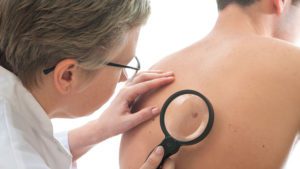Acral Lentiginous Melanoma
What is Acral Lentiginous Melanoma?
Acral Lentiginous Melanoma (ALM) is a type of skin cancer. It is a malignant melanoma that is found on the palms of the hands and the soles of the feet.
ALM affects both genders and races equally, but it is it usually discovered in people over the age 40. It is not related to sun exposure like other forms of skin cancer. ALM is the leading cause of melanoma in people with darker skin.
What are the symptoms of Acral Lentiginous Melanoma?
Common symptoms of Acral Lentiginous Melanoma include the following:- A dark spot of skin that’s surrounded by skin that remains your normal skin color. There’s a clear border between the dark skin and the lighter skin around it. Generally found on or around your hands and feet, or in the nail beds.
- Asymmetry: Moles that are cancerous usually have asymmetrical appearance in that the the moles halves don’t look like each other. Non-cancerous moles generally are round and both halves of the mole are identical.
- Border irregularity: ALM moles have a rugged or uneven border. Moles that are non-cancerous typically have straight and very clearly defined borders.
- Color variation: ALM moles will have multiple colors of brown, blue, black, or other similar colors. Moles that are non-cancerous usually are just one color and the vast majority are usually brown.
- Large diameter: The mole that is found in ALM is larger than non-cancerous moles. Moles associated with ALM are a quarter of an inch around. Non-cancerous moles are typically much smaller.
- Evolving: Cancerous moles like ALM will change. They can grow or change colors. Non-cancerous moles usually don’t change.
What causes Acral Lentiginous Melanoma?
ALM’s underlying cause of is not well understood, bu it is not related to sun exposure like other forms of skin cancer. It’s believed that genetic mutations contribute to the development of acral lentiginous melanoma.How is Acral Lentiginous Melanoma diagnosed?
ALM diagnosis starts with a physical exam of the mole itself. The mole has a characteristic look an that will help the doctor choose the correct tests to confirm. If the exam gives the doctor a reason to suspect cancer a biopsy on the mole will be ordered. A small sample from the tumor is extracted using a needle to be examined by a pathologist.What are the treatments for Acral Lentiginous Melanoma?
Treatment of ALM starts with surgical intervention. The mole is removed, along with some of the skin surrounding it. If ALM has spread to the lymph nodes, they will be surgically removed as well. This treatment usually cures it. If tumor removal doesn’t work then drugs will be used to treat the disease. The FDA has approved one drug for ALM treatment. That drug, aldesleukin (Proleukin) is used to treat ALM.Where can I find out more about Acral Lentiginous Melanoma?
Acral Lentiginous Melanoma Articles

Acral Lentiginous Melanoma (ALM) Rates Higher in Southeast Asian Individuals than Other Asian Groups
Jessica Lynn
April 4, 2023
Read More »

Researchers Develop Deeper Understanding of Acral Lentiginous Melanoma
Jessica Lynn
April 20, 2022
Read More »



